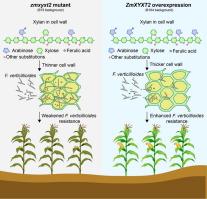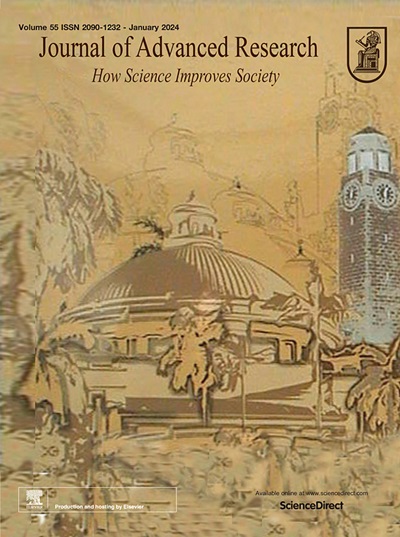Enhancing maize resistance to Fusarium verticillioides through modulation of cell wall structure and components by ZmXYXT2
IF 11.4
1区 综合性期刊
Q1 MULTIDISCIPLINARY SCIENCES
引用次数: 0
Abstract
Introduction
Fusarium verticillioides (F. verticillioides) is a prevalent phytopathogen that incites severe diseases in maize, resulting in substantial reductions in grain yield and quality. Despite its widespread impact, the genetic mechanisms underlying resistance to this pathogen remain elusive, with only a limited of resistant genes having been identified to date.Objectives
Characterize the function of ZmXYXT2 encoding a putative xylan xylosyltransferase in maize defense against F. verticillioides-induced diseases.Methods
Real-time quantitative PCR and transitory transformation of maize protoplasts were conducted to analyze the expression pattern and subcellular localization of ZmXYXT2. The zmxyxt2 mutant, sourced from an ethyl methanesulfonate mutagenesis library, and the ZmXYXT2-overexpressing plants, generated via Agrobacterium tumefaciens-mediated transformation, were utilized for artificial inoculation with F. verticillioides followed by disease severity assessments. Phenotypic assessments, cytological observations, analysis of cell wall components, and histochemical staining were performed to elucidate the regulatory mechanisms of ZmXYXT2.Results
The absence of ZmXYXT2 renders maize vulnerable to F. verticillioides-caused seedling blight, stalk rot, ear rot and seed rot, along with a notable increase in fumonisin B1 accumulation. Conversely, maize plants overexpressing ZmXYXT2 exhibited significantly heightened immunity to these diseases. Moreover, overexpression of ZmXYXT2 results in notable changes in the composition of maize cell walls, specifically increasing the levels of arabinose, xylose and ferulic acid. These alterations lead to cell wall thickening, effectively barring the intracellular invasion and colonization of F. verticillioides, thereby halting pathogen dissemination between cells. Intriguingly, maize plants overexpressing ZmXYXT2 exhibit enhanced stem strength without compromising yield-related traits.Conclusion
ZmXYXT2 provides maize with resistance to multiple diseases triggered by F. verticillioides and mitigates the accumulation of fumonisin B1. Our study presents a novel approach to bolster maize comprehensive resistance against F. verticillioides-induced diseases by modifying cell wall composition to strengthen its natural defenses.

求助全文
约1分钟内获得全文
求助全文
来源期刊

Journal of Advanced Research
Multidisciplinary-Multidisciplinary
CiteScore
21.60
自引率
0.90%
发文量
280
审稿时长
12 weeks
期刊介绍:
Journal of Advanced Research (J. Adv. Res.) is an applied/natural sciences, peer-reviewed journal that focuses on interdisciplinary research. The journal aims to contribute to applied research and knowledge worldwide through the publication of original and high-quality research articles in the fields of Medicine, Pharmaceutical Sciences, Dentistry, Physical Therapy, Veterinary Medicine, and Basic and Biological Sciences.
The following abstracting and indexing services cover the Journal of Advanced Research: PubMed/Medline, Essential Science Indicators, Web of Science, Scopus, PubMed Central, PubMed, Science Citation Index Expanded, Directory of Open Access Journals (DOAJ), and INSPEC.
 求助内容:
求助内容: 应助结果提醒方式:
应助结果提醒方式:


